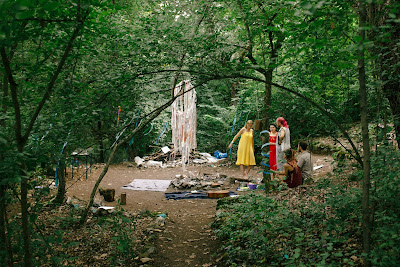Perplexing Reflections: Tomasz Piars (PL), Bea Kusovszky (HU), Michał Janowski (PL) (September 2017)
PERPLEXING REFLECTIONS exhibition
Opening on September 6th, 2017 at 7 pm in KUBIK coworking gallery
Artists: Bea Kusovszky (HU), Tomasz Piars (PL), Michał Janowski (PL)
Opening speech by Flóra Mészáros art historian
Curator: Patrycja Rup, art manager
KUBIK coworking gallery / Jászai Mari tér 5-6. Budapest
“must be detached, placed outside and before one’s eyes... and it must be different from the thing. The image is a thing that is not the thing: it distinguishes itself from it, essentially”
Jean-Luc Nancy
Hypnotizing and disquieting depictions link familiar motives in troubling collages, provoking the viewer and inviting him for a visual game to question his reliance on perception. Perplexing reflections presents a selection of paintings calling into question the function of visibility as the theme of the artwork. Paintings exist as independent objects but they simultaneously offer an image – the representation where dualism of iconic difference and immersion is established in relation to the observer as subject. Gottfried Boehm called iconic difference the possibility of spotting the difference where the viewer is breaking the continuity of perceived objects, visually distinguishing the picture from its surrounding. Meanwhile, immersion comes from the representational characteristic of the image, “erasing the line of the cut between the pictorial and the non-pictorial surface”, according to Kresimir Purgar. Here, the viewer draws a distinction between reality in images and actual reality. The selected paintings can be characterized by the strong bond between the medium and its content. People can approach the paintings critically by observing the representational abilities thereof and at the same time, the works of art can refer to the viewer’s capability of experiencing something as an image.
Following Boehm and Nancy findings, certain kinds of art, such as abstract paintings, are essential as independent objects, easily “cut out” from reality; they refer to their own surface only and do not tend to imitate objects or become their representation. In contrast, illusory, highly-mimetic pictures, such as these representations of hyperrealism, attempt to maintain the continuity between the surface of the picture and its surrounding to trick the viewer’s sight. How do contemporary paintings respond to these strategies? How do we, as viewers, perceive reality and truthfulness in paintings while living in an era dominated by new media? How can paintings respond to the rules that appear in our current non-objective post-truth age?
Hungarian artist Bea Kusovszky includes representations of famous artworks in her paintings, drawing ideas from abstract expressionism to pop art, creating a multi-layered reference system based on pop culture and famous art-historical narrations. Well-known art pieces created by Roy Lichtenstein become a mere background for the image of the artist herself, presented frontally, often undressed and pictured with a hyperrealistic technique. Kusovszky creates a feminist answer to the “old masters”: she reflects on the phenomenon occurs in case of Lichtenstein who is established as one of the major male figures of American art geniuses. In a wider context, she refers to the art-historical canon in which largely male artists represent “universality”. She creates depictions of her female body, exploited and submissive, to track, analyse and answer many infamous clichés restricting the female body to sexual functions.
While Kusovszky’s pictures negate themselves as paintings and tend to establish themselves as photography or continuous reality, Polish painter and Budapest-based curator, Tomasz Piars, addresses the viewer’s visual memory in order to analyze the difference between what is visible on the image surface and what is presented by the painted surface. His “collages” consist of multiple elements and recall a broken mirror with its scattered pieces, a big art-historical puzzle where the viewer complements the story. While these excerpts from different time dimensions, traditions and visual orders occur on the same surface, they do not endeavor to have integrity but still stress the sharpness and diversity of one another. The artistic picture reveals its internal structure: tools, methods and purpose.
Michał Janowski, artist of Polish origin also believes that painting has more to offer than a copy of common reality. Essentially, painting allows both the creator and the viewer to challenge the established truths, to shift their focus and explore. Nicholas Johnston, art collector, described the nature of Janowski’s paintings accurately:
“The principal intention leading Janowski’s work is to explore how the contradictory tensions of contemporary life can diminish us as human beings; and how, in an age when the individual has become ostensibly paramount, society grows increasingly de-personalized, materialistic and spiritually repressive.”
Painters’ visions go much further than the depiction of reality; instead, they come from a dark surreal imaginarium; figurative art disintegrates into abstractive flows on their surface. Realistically depicted elements occur as a bait in order to draw the viewer’s attention, who would later be guided through a fusion of nightmarish visions of the conscious and the subconscious. These mysterious and discomforting “collages” remain in a kind of semantic limbo between the seeable and the sayable.
During our current digital age in visual culture, a considerable shift deprived painted images of their primal mimetic purpose. They were anticipated by new media to create a precise depiction of reality. However, after this powerful change, paintings can respond to virtual reality of digital media from a new critical perspective. Perplexing reflections approaches these strategies and poses a question how contemporary paintings as material objects address reality outside the frame.
Press info:















